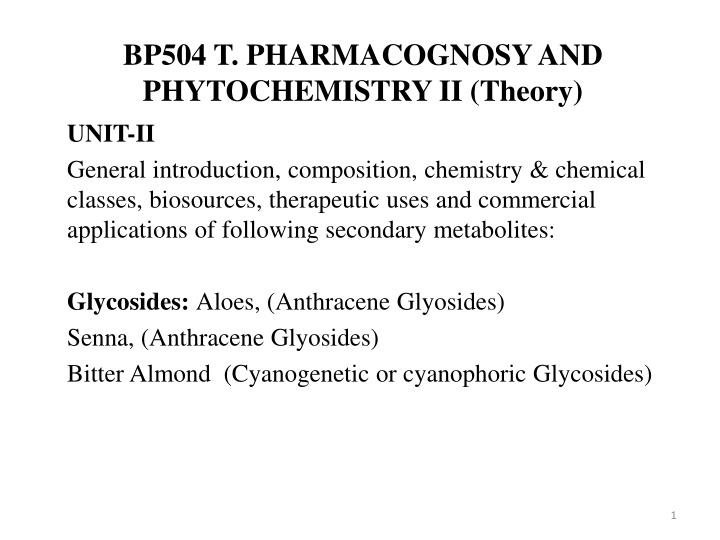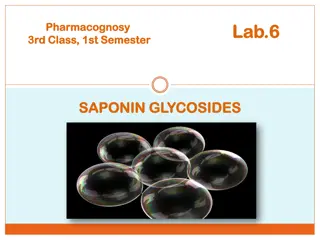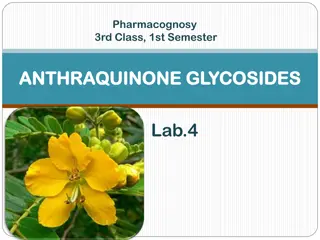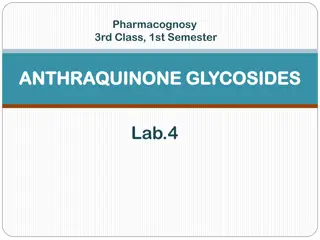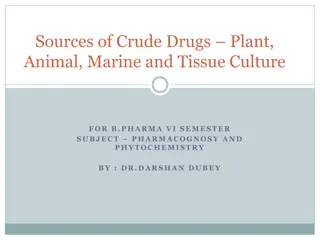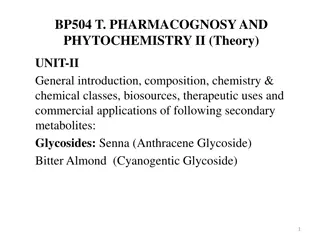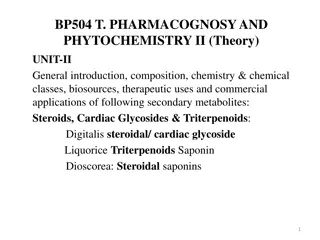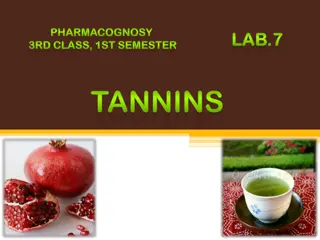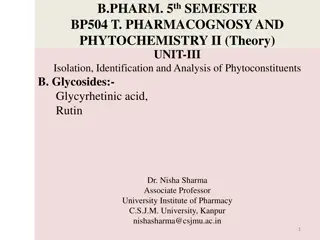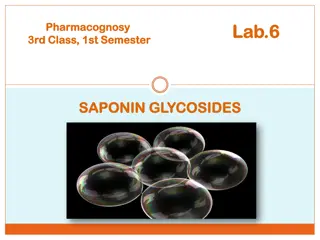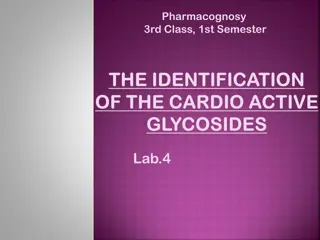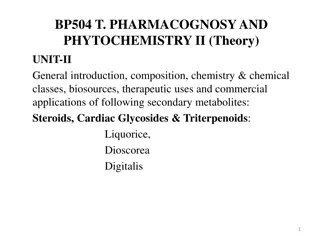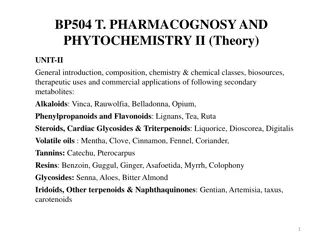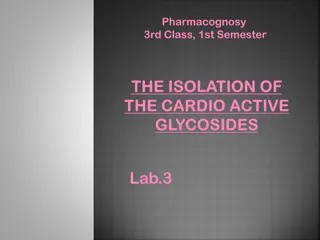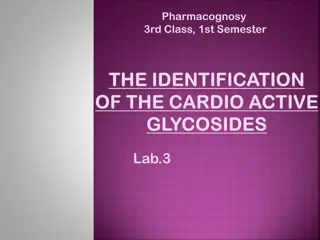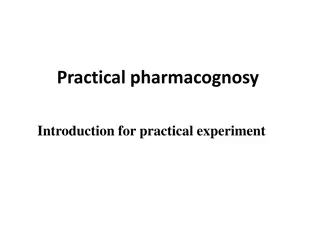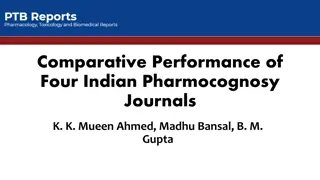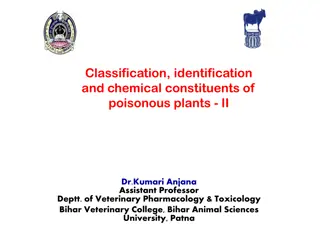Anthracene Glycosides in Pharmacognosy and Phytochemistry
Anthracene glycosides are secondary metabolites found in various plant families, offering therapeutic benefits. This comprehensive study explores their composition, chemistry, biosources, and applications, detailing the structural variations of aglycones and sugars present in these compounds. Methods for identification and characterization, such as Borntrager's test, are discussed, highlighting the biological significance of reduced anthraquinone derivatives.
Download Presentation

Please find below an Image/Link to download the presentation.
The content on the website is provided AS IS for your information and personal use only. It may not be sold, licensed, or shared on other websites without obtaining consent from the author.If you encounter any issues during the download, it is possible that the publisher has removed the file from their server.
You are allowed to download the files provided on this website for personal or commercial use, subject to the condition that they are used lawfully. All files are the property of their respective owners.
The content on the website is provided AS IS for your information and personal use only. It may not be sold, licensed, or shared on other websites without obtaining consent from the author.
E N D
Presentation Transcript
BP504 T. PHARMACOGNOSY AND PHYTOCHEMISTRY II (Theory) UNIT-II General introduction, composition, chemistry & chemical classes, biosources, therapeutic uses and commercial applications of following secondary metabolites: Glycosides: Aloes, (Anthracene Glyosides) Senna, (Anthracene Glyosides) Bitter Almond (Cyanogenetic or cyanophoric Glycosides) 1
Anthracene Glyosides Families like Euphorbiaceae, Ericaceae, Lythraceae, Polygonaceae, Rhamnaceae, Rubiaceae, Leguminosae, Verbenaceae, etc. Family Liliaceae from monocots also shows the presence of C-glycosides. Some of fungi & lichens also contain anthraquinone glycosides. But, it is observed that lower plants like Bryophytes, Pteridophytes and Gymnosperms are devoid of such glycosides. 2
Anthracene Glyosides Postulated that the aglycone part of these glycosides is formed by head-to-tail condensation of acetate units. This group of glycosides comprises of different aglycone moieties like anthraquinone, anthrone, anthranol, dianthranol, oxanthrone and dianthrone. In different drugs like aloe, senna, rhubarb, cascara, aglycones are present in their derivate forms. The parent molecule for all these aglycones i.e. anthraquinone is present in different forms along with methyl, hydroxymethyl, carboxyl, dihydroxy phenol, trihydroxy phenol or free carboxylic acid groups. 3
Anthracene Glyosides In a reduced form, anthraquinone is present as anthranol or anthrone which are isomeric with each other. Anthrone is pale yellow substance without any solubility in alkali, while anthranol is brownish- yellow and soluble in alkali. Anthranol shows strong fluorescence in alkali, but anthrone is non-fluorescent by nature. Some plants contain oxanthrone an intermediate substance from anthraquinone to anthranol. In some plants, anthrone molecule orients in bimeric form called dianthrone which is therapeutically more important. 4
Anthracene Glyosides Reduced anthraquinone are biologically more active. In fresh drug, these aglycones are present in reduced form, but are hydrolysed & oxidized during their storage. They are present along with different sugars like glucose, rhamnose, arabinose and primeverose. Borntrager's Test: Powdered drug + extract with ether or any water immiscible organic solvent filter ethereal extract made alkaline with caustic soda or ammonia aqueous layer after shaking pink, red or violet color. Borntrager's test - negative in case of anthranol (reduced forms). Anthrones are detected with their fluorescence tests. 5
Aloes Aloe, Musabbar, Ghrit-Kumari. B S: Dried juice of leaves of Aloe barbadensis, known as Curacao aloes; or of Aloe perryi, known as Socotrine aloes; or of Aloe ferox & hybrids of this species with Aloe africana & Aloe spicata known as Cape aloes, family Liliaceae. G S: indigenous to eastern & southern Africa & grown in Cape colony, Zanzibar & islands of Socotra. also cultivated in Caribbean islands, Europe & many parts of India, including North West Himalayan region. 7
Aloes History: word aloes-originated Arabic word alloch meaning shining bitter substance. 'vera' means true, 'ferox' means wild, 'spicata' refers to flowers in spikes, & 'barbadensis & 'africana' refer to habitat of plant. Among folklore uses, in Congo region of Africa, natives used to rub mucilage of leaves for reducing perspiration & masking of human odor, thereby offering protection from wild animals. Aloe barbadensis used along with burnt alum for healing sore eyes. 8
Aloes: Cultivation & Collection About 200 species, plants have rosettes of subdulate, succulent large leaves. Leaves-sessile, strong spine at apex, number of spines along margins. lower portion rounded, upper concave. Cultivation- root suckers for propagation. Plants grow even in poor grades of soils, dry climatic conditions. Root suckers- planted in rows about 50 cm apart. Water logging near the plant must be prevented. The roots do not penetrate much in the soil. Manure- mixture of N2, K, P is used. Leaves are cut for 1st instance in 2nd yr of cultivation & drug is obtained from leaves for 12 yrs. 9
Aloes: Preparation After 12 yrs, plants are completely harvested by uprooting & again the land is prepared for replantation. Collection of leaves- cut is given to leaves near their bases, juice located in parenchymatous cells of pericycle exudes out, due to pressure exerted by mucilage cells. Single incision is sufficient for drawing out all the juice from entire system of pericyclic cells. Preparation of Aloe : i. Barbados or Curacao aloes: prepared in islands of Aruba & Bonaire in West Indies. Transverse cuts near bases of fleshy leaves of Aloe barbadensis, cut leaves placed along the sides of V-shaped wooden troughs. Because of spines on leaves, put into kerosene tins immediately after cutting, then brought to wooden troughs, kept in tilted positions, to drain out all the juice 10
Aloes: Preparation The juice collected is allowed to boil in large copper pans. During boiling, latex evaporates & juice is further thickened. The thick juice then poured into gourds or metal containers where it hardens. It is brought in market under the name Barbados or Curacao aloe. ii. Socotrine aloes: Prepared from Aloe perryi - island of Socotra & mainland of East Africa. Juice of leaves collected in goat skin & allowed to become semisolid. Exported in pasty condition under the name of Socotrine aloe. 11
Aloes: Preparation iii. Cape aloes: From Aloe ferox & its hybrids in South Africa. Transversely cut leaves- arranged in circular manner in the basin shaped depression, dug in the ground which is lined either with goat skin or canvas. Leaves are placed in a way so as to overlap the cut ends. Kept for 5 - 6 hours, till all juice exudes out & is collected in goat skin. Collected juice- transferred to large iron kettle, boiled, stirred with a wooden paddle type instrument. Boiling juice attains a desired concentration, poured into wooden cases, becomes solid mass, brought into commerce under name of Cape aloe 12
Aloes: Preparation iv. Zanzibar aloes: origin of this variety not correctly known & sometimes, regarded as a variety of Socotrine aloe. Juice is poured into skins of some small carnivorous animals, where it solidifies & as such packed in wooden boxes. Zanzibar aloe is also sometimes, called as monkey-skin aloe, although the skin is not that of monkeys. 13
Aloes: Preparation Cape Aloes Curacao Aloes Cape Barbados, livery variety Strong odor like iodoform Taste-Bitter Socotrine Aloes Zanziber Aloes Sour & distinct Unpleasant Characteristic, not much disagreeable Bitter Nauseating & bitter Dark brown, greenish brown to olive brown mass Nauseating & bitter Brownish yellow Opaque mass Brownish black, opaque mass Liver brown , dull Waxy, resinous Uneven fractured surface Livery Curacao & capey barbados- distinguished by their transparency Pasty or semisolid Conchoidal waxy Smooth & even glassy fracture 14
Aloe: Microscopic characters of powder Curacao Aloes Cape Aloes Shows Fragments Crystalline- Insoluble in cresol, shining bright color color Socotrine Fragments Zanziber Irregular lumps Brown, angular or irregular fragments Amorphous- dissolves fast- no Large no. of very small needles or slender prisms Transparent Large prisms, in group or dispersed Modular masses are embedded 15
Aloes: CC All aloe- source of anthraquinone glycosides. Principal active constituent of aloe- aloin, is a mixture of glucosides, barbaloin the chief constituent. Chemically it is aloe-emodin anthrone C - 10 glucoside, water soluble. Barbaloin- C-glycoside, not hydrolysed by heating with dil. acids or alkalis. Ferric chloride decomposes barbaloin by oxidative hydrolysis into aloe-emodin-anthrone, little aloe-emodin & glucose. Aloes also contain isobarbaloin, barbaloin, aloe- emodin & resins. 16
Aloes: CC Also contains aloetic acid, homonataloin, aloesone, chrysophanic acid, chrysamminic acid, galactouronic acid, choline, choline salicylate, saponins, mucopolysaccharides, glucosamines, hexuronic acid, coniferyl alcohol, etc. Amount of barbaloin in different commercial varieties varies greatly. Curacao aloes- 22% barbaloin Indian variety- Aloe vera, very less quantity (3.5 - 4 %) Curacao aloes- 2 times quantity of aloe-emodin, as compared to Cape-aloe-emodin. Resin of aloe- Aloesin, type of C-glucosyl chromome, Aloesin -also responsible- purgative action of aloes. 17
Structures 18
General Chemical Tests 1 g of aloe powder + boiled with 10 ml water, filtered with help of kieselguhr. Filtrate used for Br2 test and Schoenteten's reaction. 1) Br2 test: Freshly prepared Br2 sol. + small qty of above filtrate pale yellow ppt of tetrabromalin. 2) Schoenteten's reaction (Borax test): Little qty of above filtrate+ borax+ shake till borax dissolves. When few drops of this solution are added to a test tube nearly filled with water, a green fluorescence appears. 19
Specific Test To distinguish different varieties of aloe vera (1) Nitrous acid test: Crystals of NaNO2 + small qty CH3COOH + aq. sol of aloes. The observations are as follows: (i) Curacao aloes - sharp pink to carmine color (ii) Cape aloes - faint pink color (iii) Socotrine & Zanzibar aloes - very less change in color. This test is due to isobarbaloin. 20
Specific Test 2. HNO3 test: carried out either by directly applying HNO3 to drug or to its aq. Sol. Following observations : i) Curacao aloes - deep brownish-red color ii) Cape aloes - brownish color changes green iii) Socotrine aloes - pale brownish - yellow color iv) Zanzibar aloes - yellowish brown color 21
Specific Test: Cupraloin test (Klunge's isobarbaloin test): 2. Dil. Aq. Sol. of aloes + drop of sat. CuSO4 sol. + NaCl drops + excess of 90% alcohol Following Obseervations: i) Curacao aloes - wine red color persists 4 hrs ii) Cape aloes - faint color rapidly changes to yellow iii) Socotrine aloes - no color iv) Zanzibar aloes - no color 22
Specific Test: Modified anthraquinone test 4. Indicates presence of C-glycosides, viz. aloe emodin. Aq. Sol. of aloes + FeCl3 sol. + dil. HCl oxidative hydrolysis of aloe-emodin sets free anthraquinones collected in organic solvent CCl4 or ether. Organic layer separated, shaken with dil. NH3 Ammoniacal layer shows rose-pink to cherry red color, indicates presence of C-glycosides, viz. aloe emodin. 23
Uses As a purgative, acts on mainly on colon. Has stronger purgative action in the series of all crude drugs with anthracene glycosidal content. To counter effect the gripping action, given with carminatives. Aloin is preferred now-a-days to aloes, both of which are official. Besides purgative property, aloes many other uses. Ingredient of compound tincture of benzoin (Friar's balsam) 24
ALOE GEL Formed in inner parenchymal cells of leaf, slightly viscous & clear liquid While collection, should not get contaminated with aloe juice Such gel - used in topical therapeutic applications & in cosmetic products, but therapeutic value if taken orally, is questionable. Gel possesses good moisturizing properties, has formulation role for oil in water (approved by U.S.F.D.A.) preparation. Shows anti-inflammatory properties due to salicylates, carboxy peptidases (inactivating bradykinen) & magnesium lactate (interfering with the conversion of histidine to histamine in the mast cells). 25
ALOE GEL The polysaccharide & sugar content have the role for hydrocolloid dressing & also osmotic bactericides. It also increases the removal of dead tissue due to its Aloctine - A content which stimulates macrophage production. Believed that only fresh gel has role in treatment of burns & wounds. Also used in treatment of pains & itchings & also to slow down ulceration & keratosis, Used in skin cosmetics as protective due to its antiwrinkle properties. Aloe is also used externally for painful inflammation. 26
Other Preparations 1) Aloin: mixture of crystalline principles obtained from aloes. varies both in chemical composition & physicochemical properties, depending upon the source of aloes from which it is prepared. Generally, it is pale yellow to dark yellow & microcrystalline powder. Odorless, intense taste, soluble in water & 90% alcohol. Store in tight light resistant container. Effective dose-15-60 mg -purgation. 2) Aloes powder: characters vary as/ source of aloes used for preparation. Source identified with help of microscopic observations. 28
Other Preparations 3) Compound benzoin tincture (Friar's balsam): consists of benzoin, prepared storax, balsam of tolu, aloes & 90% alcohol. Adulterants & Substitutes 1) Natal Aloes: resembles cape aloes in microscopic characters, hence used as substitute. Contains natalion, homonatalion, & resin with nataloresinotannol. weak purgative. 2) Mocha Aloes: brittle, black, & glassy aloes with strong odor. 3) Adulterated with black catechu, pieces of iron & stones. Alcoholic extract of aloe under UV light gives deep brown color, while black catechu gives black color. 29
Reference Pharmacognosy, C.K. Kokate, A.P. Purohit, S.B. Gokhale, 54th Ed. 2017, Nirali Publication, New Delhi 30
